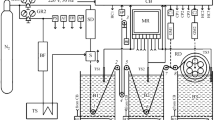Abstract
Polysulfones are synthesized in aprotic dipolar solvents, such as dimethylacetamide, N-methyl-2-pyrrolidone, and dimethyl sulfoxide, in a wide range of molecular weights from 42 000 to 184 000 g/mol for hollow-fiber membranes spinning for the first time. Dependence of the thermal and mechanical properties of polysulfones on molecular weight characteristics is investigated. A comparison of the mechanical properties of the synthesized PSF and commercial PSF Ultrason S 6010 (BASF, Germany) and PSF-150 (JSC Institute of Plastics, Russia) shows that the synthesized polymers are not inferior to their commercial analogs and some samples even surpass them in terms of the elastic modulus and strength. According to the dynamic viscosity of spinning solutions, promising PSF samples are chosen to form porous hollow-fiber supports. It is demonstrated that the hollow-fiber supports based on PSF with a molecular weight of 110 000 g/mol have a high nitrogen permeability of 47.5 m3/(m2 h bar). These supports show promise for casting composite membranes with a thin selective layer.

Similar content being viewed by others
REFERENCES
A. W. Zularisam, A. F. Ismail, M. R. Salim, M. Sakinah, and O. Hiroaki, J. Membr. Sci. 299, 97 (2007).
G. Makdissy, J. P. Croué, G. Amy, and H. Buisson, Water Sci. Technol.: Water Supply 4, 205 (2004).
Y. Kang, M. Obaid, J. Jang, M. H. Ham, and I. S. Kim, Chemosphere 207, 581 (2018).
Y. Koga, H. Fujieda, H. Meguro, Y. Ueno, T. Aoki, K. Miwa, and M. Kainoh, Artif. Organs 42, E246 (2018).
T. V. Plisko, A. V. Bildyukevich, L. Zhao, W. Huang, V. V. Volkov, and Z. Huang, Fibers 9, 28 (2021).
R. Sengur-Tasdemir, G. M. Urper-Bayram, T. Turken, E. Ates-Genceli, V. V. Tarabara, and I. Koyuncu, J. Water Proc. Eng. 42, 102100 (2021).
Y.-G. Lim, C. Bak, and Y.-D. Kim, Chem. Eng. J. 433, 134616 (2022).
S. Mansur, M. H. D. Othman, M. N. Z. Abidin, A. F. Ismail, S. H. S. Abdul Kadir, P. S. Goh, H. Hasbullah, B. C. Ng, M. S. Abdullah, and R. Mustafar, J. Environ. Chem. Eng. 9, 106141 (2021).
P. Peechmani, M. H. D. Othman, R. Kamaludin, M. H. Puteh, J. Jaafar, M. A. Rahman, A. F. Ismail, KadirS. H. S. Abdul, R. M. Illias, J. Gallagher, and S. M. Djuli, J. Environ. Chem. Eng. 9, 105873 (2021).
I. Borisov, V. Vasilevsky, D. Matveev, A. Ovcharova, A. Volkov, and V. Volkov, Fibers 7, 11 (2019).
I. Borisov, A. Ovcharova, D. Bakhtin, S. Bazhenov, A. Volkov, R. Ibragimov, R. Gallyamov, G. Bondarenko, R. Mozhchil, A. Bildyukevich, and V. Volkov, Fibers 5, 6 (2017).
D. N. Matveev, K. A. Kutuzov, and V. P. Vasilevsky, Membr. Membr. Technol. 2, 351 (2020).
A. V. Bildyukevich and V. V. Usosky, Pet. Chem. 54, 652 (2014).
Zh. I. Kurdanova, Cand. Sci. (Chem.) Dissertation, 2017.
V. V. Korshak and S. V. Vinogradova, Nonequilibrium Polycondensation (Nauka, Moscow, 1972) [in Russian].
V. V. Shaposhnikova, Doctoral Sci. (Chem.) Dissertation, 2013.
E. V. Kalugina, Doctoral Sci. (Chem.) Dissertation, 2013.
Q. Xie, S. Zhang, Z. Hong, H. Ma, C. Liu, and W. Shao, Ind. Eng. Chem. Res. 57, 16464 (2018).
Y. Thuyavan, N. Anantharaman, G. Arthanareeswaran, and A. F. Ismail, J. Chem. Technol. Biotechnol. 91, 2568 (2016).
A. V. Bildyukevich, T. V. Plisko, and V. V. Usosky, Pet. Chem. 56, 379 (2016).
D. Matveev, I. Borisov, V. Vasilevsky, G. Karpacheva, and V. Volkov, Membranes 12, 1257 (2022).
E. A. Grushevenko, I. L. Borisov, D. S. Bakhtin, G. N. Bondarenko, I. S. Levin, and A. V. Volkov, React. Funct. Polym. 134, 156 (2019).
E. A. Grushevenko, I. L. Borisov, A. A. Knyazeva, V. V. Volkov, and A. V. Volkov, Sep. Purif. Technol. 241, 116696 (2020).
ACKNOWLEDGMENTS
This study was carried out using the equipment of the Shared Research Center Analytical Center of Deep Oil Processing and Petrochemistry, Topchiev Institute of Petrochemical Synthesis, Russian Academy of Sciences.
Funding
This study was supported by the Russian Science Foundation, grant no. 19-19-00647, https://rscf.ru/project/19-19-00647/.
Author information
Authors and Affiliations
Corresponding author
Ethics declarations
The authors declare that they have no conflicts of interest.
Additional information
Translated by T. Soboleva
Rights and permissions
About this article
Cite this article
Borisov, I.L., Matveev, D.N., Anokhina, T.S. et al. Synthesis and Properties of Polysulfones for Fabricating Porous Hollow-Fiber Membranes. Membr. Membr. Technol. 5, 218–225 (2023). https://doi.org/10.1134/S2517751623030022
Received:
Revised:
Accepted:
Published:
Issue Date:
DOI: https://doi.org/10.1134/S2517751623030022




